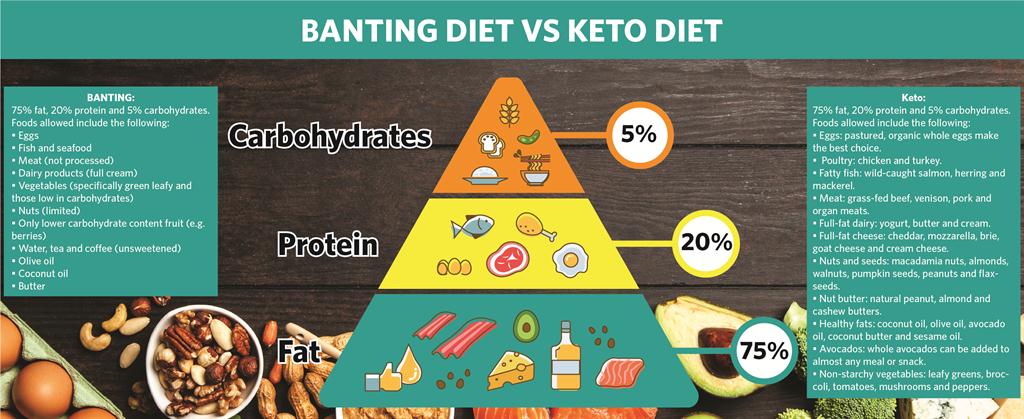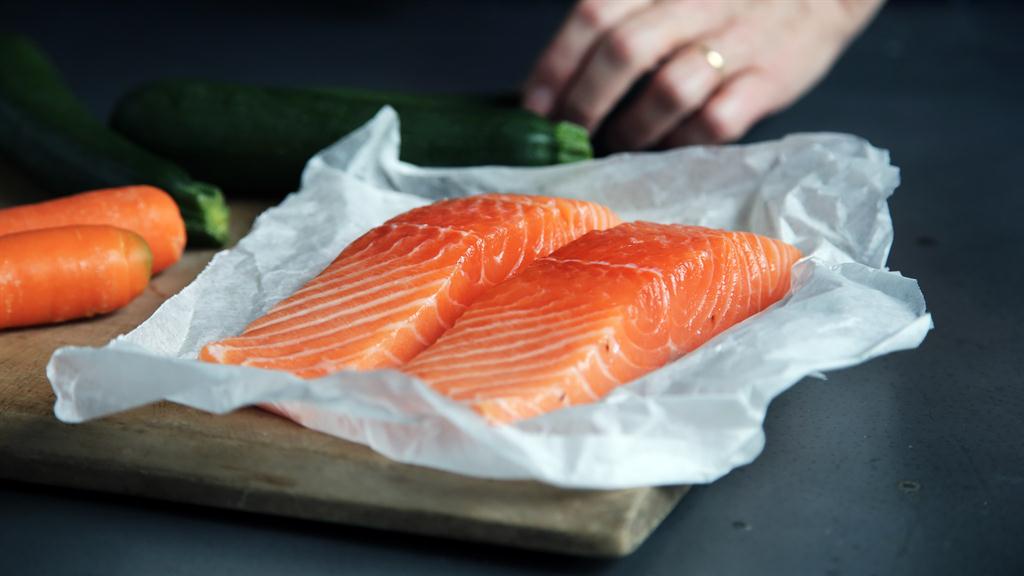To keto or to bant?
It has taken the world by storm, but is it really the healthiest option?
Henriette Lamprecht – It is currently hailed as the two most popular diets, with many boasting it was all they needed to get rid of the last stubborn kilo’s and finally convert to a healthy lifestyle. Keto and banting have taken the world by storm, but what are the differences between the two and are they really the healthiest options?
Annalien Turner, registered dietician at Eat Clean Namibia, explains banting as a diet that heavily restricts the intake of carbohydrates and favours a high intake of fats and a moderate intake of protein – especially animal protein. The macronutrient distribution for banting is roughly 75% fat, 20% protein and 5% carbohydrates.
Saturated fats are not unhealthy to consume and should be used to combat cravings to make one feel full and to prevent overeating. Banting avoids all vegetable and seed oils. It promotes the intake of mainly green vegetables since they contain less carbohydrates than other vegetables. Snacking between meals should be avoided. Intake of foods high in both protein and carbohydrates, such as legumes, should be avoided. It is also important to eat just enough food, while protein intake should be moderate. Avoid hidden carbs, too many fruits and nuts, and too much gluten. Dairy intake should be limited.
“The advantage of banting is that the dieter doesn’t get hungry as often on this diet compared to dieters on normal low-energy meal plans. This means because the dieter doesn’t feel hungry as often, he or she doesn’t eat as much food as they normally would,” says Annalien.
A disadvantage of banting is that there is very little scientific research backing the claims made. Banting restricts healthy foods such as fruits and vegetables of various colours. It also restricts most high-fibre foods such as grains and legumes. The preferred fat options in banting are generally saturated fat and healthier fat options such as nuts, vegetable and seed oils are avoided.
Various studies show there may be a link between low carbohydrate intake and the increased risk of heart disease and death.
“Since banting advocates the intake of saturated fats and little to no monounsaturated and polyunsaturated fats, dieters are developing low levels of HDL-cholesterol which is a cause of heart disease. Another unhealthy aspect of banting is the low intake of fibre. This could lead to constipation. A low fibre intake also affects blood cholesterol levels.”
Based on current research, banting is not advised for the general public.
“It is advised that individuals who would like to lose weight visit a registered dietician for an individualised meal plan that takes current health, physical activity levels and stress levels into account.”
The ketogenic diet is very similar to the banting diet, says Annalien. It focuses on a very low carbohydrate intake, a high fat intake and a moderate protein intake. “Keto” refers to ketogenesis.
“This is a process that occurs in the body when there is a low intake of carbohydrates and an increased intake of fat – in other words, your body starts breaking down fat into energy because there is no longer a carbohydrate source.”
The macronutrient distribution of the keto diet is generally the same as that of banting – 75% fat, 20% protein and 5% carbohydrates.
Advantages of keto include rapid weight loss over a short period of time. The keto diet also doesn’t cause much fluctuation in blood sugar due to low carbohydrate intake.
Disadvantages include vitamin and mineral deficiencies due to the elimination of almost an entire food group.
The constant intake of higher protein foods can also lead to kidney damage in the long run. The keto diet isn’t sustainable over a long period of time because it’s expensive. Short-term side effects may include nausea, vomiting, headache, fatigue, dizziness, insomnia, poor exercise tolerance and constipation. This is known as “keto flu”.
According to Annalien scientific research shows a ketogenic diet is effective in reducing the incidence of seizures in children with epilepsy.
In terms of weight loss, few studies investigate the effects over long periods of time. The constant intake of saturated fats increase the risk of heart disease. Micronutrient deficiencies may also develop in the long run due to the limited variety of fruits and vegetables that are consumed.
Everybody is different and will react differently to the keto diet, Annalien warns.
“In general people with medical issues should consult a registered dietician before starting with any diet or meal plan just to ensure there are no problems occuring while on the plan. Children should also not follow any restrictive diets without medical supervision since they’re still growing, and any restrictions may negatively affect their growth and general health.”
[email protected]; www.eatcleannamibia.com
Annalien Turner, registered dietician at Eat Clean Namibia, explains banting as a diet that heavily restricts the intake of carbohydrates and favours a high intake of fats and a moderate intake of protein – especially animal protein. The macronutrient distribution for banting is roughly 75% fat, 20% protein and 5% carbohydrates.
Saturated fats are not unhealthy to consume and should be used to combat cravings to make one feel full and to prevent overeating. Banting avoids all vegetable and seed oils. It promotes the intake of mainly green vegetables since they contain less carbohydrates than other vegetables. Snacking between meals should be avoided. Intake of foods high in both protein and carbohydrates, such as legumes, should be avoided. It is also important to eat just enough food, while protein intake should be moderate. Avoid hidden carbs, too many fruits and nuts, and too much gluten. Dairy intake should be limited.
“The advantage of banting is that the dieter doesn’t get hungry as often on this diet compared to dieters on normal low-energy meal plans. This means because the dieter doesn’t feel hungry as often, he or she doesn’t eat as much food as they normally would,” says Annalien.
A disadvantage of banting is that there is very little scientific research backing the claims made. Banting restricts healthy foods such as fruits and vegetables of various colours. It also restricts most high-fibre foods such as grains and legumes. The preferred fat options in banting are generally saturated fat and healthier fat options such as nuts, vegetable and seed oils are avoided.
Various studies show there may be a link between low carbohydrate intake and the increased risk of heart disease and death.
“Since banting advocates the intake of saturated fats and little to no monounsaturated and polyunsaturated fats, dieters are developing low levels of HDL-cholesterol which is a cause of heart disease. Another unhealthy aspect of banting is the low intake of fibre. This could lead to constipation. A low fibre intake also affects blood cholesterol levels.”
Based on current research, banting is not advised for the general public.
“It is advised that individuals who would like to lose weight visit a registered dietician for an individualised meal plan that takes current health, physical activity levels and stress levels into account.”
The ketogenic diet is very similar to the banting diet, says Annalien. It focuses on a very low carbohydrate intake, a high fat intake and a moderate protein intake. “Keto” refers to ketogenesis.
“This is a process that occurs in the body when there is a low intake of carbohydrates and an increased intake of fat – in other words, your body starts breaking down fat into energy because there is no longer a carbohydrate source.”
The macronutrient distribution of the keto diet is generally the same as that of banting – 75% fat, 20% protein and 5% carbohydrates.
Advantages of keto include rapid weight loss over a short period of time. The keto diet also doesn’t cause much fluctuation in blood sugar due to low carbohydrate intake.
Disadvantages include vitamin and mineral deficiencies due to the elimination of almost an entire food group.
The constant intake of higher protein foods can also lead to kidney damage in the long run. The keto diet isn’t sustainable over a long period of time because it’s expensive. Short-term side effects may include nausea, vomiting, headache, fatigue, dizziness, insomnia, poor exercise tolerance and constipation. This is known as “keto flu”.
According to Annalien scientific research shows a ketogenic diet is effective in reducing the incidence of seizures in children with epilepsy.
In terms of weight loss, few studies investigate the effects over long periods of time. The constant intake of saturated fats increase the risk of heart disease. Micronutrient deficiencies may also develop in the long run due to the limited variety of fruits and vegetables that are consumed.
Everybody is different and will react differently to the keto diet, Annalien warns.
“In general people with medical issues should consult a registered dietician before starting with any diet or meal plan just to ensure there are no problems occuring while on the plan. Children should also not follow any restrictive diets without medical supervision since they’re still growing, and any restrictions may negatively affect their growth and general health.”
[email protected]; www.eatcleannamibia.com







Comments
Namibian Sun
No comments have been left on this article